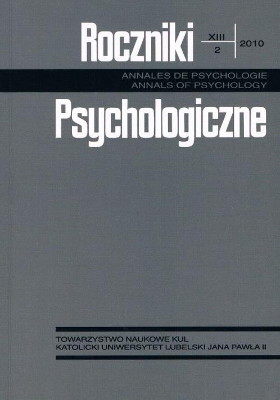Characteristics of self-consciousness and intensity of depressive symptoms
Abstract
The issue of this article is to examine the relation between forms of self-consciousness and depression. It presents studies of a normal sample of 76 students and clinical sample of 15 patients with depression. Self-consciousness Scale (Zaborowski, 1989) has been used to assess forms of selfconsciousness and Center for Epidemiological Studies - Depression (Radloff, 1977) has been used to measure depression. There are two main goals of the research: 1) distinction of typological groups of healthy controls in context of self-consciousness variables; 2) description of changes in intensity of depressive symptoms in relation to the types of self-consciousness structure differentiated. The cluster analysis has shown 3 types of self-consciousness structures which differ with respect to the all forms of self-consciousness as well as to the level of depressive symptoms. It has also turned out that the most depressive self-consciousness structure differentiated was similar to the one of patients suffering from depression.
References
Bernstein, I. H., Teng, G., Garbin, C. P. (1986), A confirmatory factoring of the Self-Consciousness Scale. Multivariate Behavioral Research, 21, 459-475.
Burnkrant, R. E., Page, T. J. (1984). A modification of the Fenigstein, Scheier, and Buss Self-Consciousness Scales. Journal of Personality Assessment, 48, 6, 629-637.
Carver, C. S., Scheier, M. F. (1987). The blind men and the elephant: Selective examination of the public-private literature gives rise to faulty perception. Journal of Personality, 55, 3, 525-541.
Csikszentmihalyi, M., Figurski, T. J. (1982). Self-awareness and aversive experience in everyday life. Journal of Personality, 50, 15-28.
Davies, M. F. (1996). Self-consciousness and the complexity of private and public aspects of identity. Social Behavior and Personality: An International Journal, 24, 2, 113-118.
Fejfar, M. C., Hoyle, R. H. (2000). Effect of private self-awareness on negative affect and self-referent attribution: A quantitative review. Personality and Social Psychology Review, 4, 2, 132-142.
Fenigstein, A., Scheier, M. F., Buss, A. (1975). Public and private self-consciousness: Assessment and theory. Journal of Consulting and Clinical Psychology, 43, 522-527.
Fleckhammer, L. (2004). Insight into the self-absorption paradox: The development of a multi-faceted model of self-conscious ruminative and reflective thought. Australia: Swinburne University of Technology; http://adt.lib.swin.edu.au/uploads/approved/adt-VSWT20050913.152247/public/ 02whole.pdf (16.05.2006).
Fromson, P. M. (2006). Self-discrepancies and negative affect: The moderating roles of private and public self-consciousness. Social Behavior and Personality, 34, 4, 333-350.
Hammen, C. (2004). Depresja. Modele kliniczne i techniki terapeutyczne. Gdańsk: Gdańskie Wydawnictwo Psychologiczne.
Hull, J. G., Levy, A. S. (1979). The organizational functions of the self: An alternative to the Duval and Wicklund Model of Self-Awareness. Journal of Personality and Social Psychology, 37, 5, 756-768.
Ingram, R. E., Wisnicki, K. (1999). Situational specificity of self-focused attention in dysphoric states. Cognitive Therapy and Research, 23, 6, 625-636.
Langer, E. J. (1993). Problemy uświadamiania. Konsekwencje refleksyjności i bezrefleksyjności. W: T. Maruszewski (red.), Poznanie. Afekt. Zachowanie (s. 137-179). Warszawa: Wydawnictwo Naukowe PWN.
Lyubomirsky, S., Nolen-Hoeksema, S. (1995). Effects of self-focused rumination on negative thinking and interpersonal problem-solving. Journal of Personality and Social Psychology, 69, 1, 176-190.
Martin, A. J., Debus, R. L. (1999). Alternative factor structure for the revised self-consciousness scale. Journal of Personality Assessment, 72, 2, 266-281.
Millon, T., Davis, R. (2005). Zaburzenia osobowości we współczesnym świecie. Warszawa: Instytut Psychologii Zdrowia PTP.
Moberly, N. J., Watkins, E. R. (2006). Processing mode influence the relationship between trait rumination and emotional vulnerability. Behavior Therapy, 37, 281-291.
Nasby, W. (1985). Private self-consciousness, articulation of the self-schema, and recognition memory of trait adjectives. Journal of Personality and Social Psychology, 49, 3, 704-709.
Nasby, W. (1989). Private and public self-consciousness and articulation of the self-schema. Journal of Personality and Social Psychology, 56, 1, 117-123.
Panayiotou, G., Kokkinos, C. M. (2006). Self-consciousness and psychological distress: A study using the Greek SCS. Personality and Individual Differences, 41, 63-93.
Pyszczynski, T., Holt, K., Greenberg, J. (1987). Depression, self-focused attention, and expectancies for positive and negative future life events for self and others. Journal of Personality and Social Psychology, 52, 5, 994-1001.
Radloff, L. S. (1977). The CES-D Scale: A self-report depression scale for research in the general population. Applied Psychological Measurement, 1, 385-401.
Ruiperez, M. A., Belloch, A. (2003). Dimensions of the self-consciousness scale and their relationship with psychopathological indicators. Personality and Individual Differences, 35, 829-841.
Seligman, M. (1993). Optymizmu można się nauczyć. Poznań: Media Rodzina.
Seligman, M. E. P., Walker, E. F., Rosenhan, D. L. (2003). Psychopatologia. Poznań: Wydawnictwo Zysk i S-ka.
Sęk, H. (2005). Psychologia zaburzeń afektywnych. W: H. Sęk (red.), Psychologia kliniczna (t. 2, s. 100-119). Warszawa: Wydawnictwo Naukowe PWN.
Trapnell, P. D., Campbell, J. D. (1999). Private self-consciousness and the five-factor model of personality: Distinguishing rumination from reflection. Journal of Personality and Social Psychology, 76, 2, 284-304.
Trudeau, K. J., Reich, R. (1995). Correlates of psychological mindedness. Personality andIndivid- ual Differences, 19, 5, 699-704.
Wood, J. V., Saltzberg, J. A., Neale, J. M., Stone, A. A., Rachimel, T. B. (1990). Self-focused attention, coping responses, and distressed mood in everyday life. Journal of Personality and Social Psychology, 58, 6, 1027-1036.
Wu, J. K.-F., Watkins, D. (2006). Testing competing factor models underlying the private self-consciousness scale with Hong Kong Chinese adolescents. Social Behavior and Personality, 34, 10, 1245-1258.
Zaborowski, Z. (1989). Psychospołeczne problemy samoświadomości. Warszawa: PWN.
Zaborowski, Z. (1994). Współczesne problemy psychologii społecznej i psychologii osobowości. Warszawa: Profi.
Zaborowski, Z. (2000). Teoria treści i form samoświadomości. Warszawa: Wydawnictwo Akademickie Żak.
Zaborowski, Z. (2001). Problemy psychologii życia. Warszawa: Wydawnictwo Akademickie Żak
Zaborowski, Z. (2002). Człowiek, jego świat i życie. Warszawa: Wydawnictwo Akademickie Żak.
Copyright (c) 2010 Roczniki Psychologiczne

This work is licensed under a Creative Commons Attribution-NonCommercial-NoDerivatives 4.0 International License.


